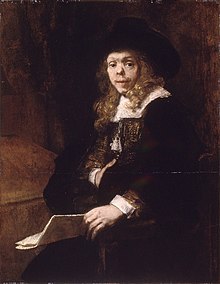Gerard de Lairesse

Gerard de Lairesse (born September 11, 1640 or 1641 in Liège , † before June 28, 1711 in Amsterdam ) was a Dutch painter , etcher and mezzotint engraver .
Life
De Lairesse was first a student of his father Renier de Lairesse (around 1597-1667) and from 1655 by Bertholet Flémal . After his eldest brother returned from Italy, he took artistic instructions from a book by Cesare Ripa . He received his first commissions in Cologne from Elector Maximilian Heinrich von Bayern , who was also Prince-Bishop of Liège. In 1664 he fled to Maastricht after an argument in which his nose was injured . He married his cousin Marie Selme in Navagne near Maastricht. He moved to Utrecht and then to Amsterdam after the art dealer Gerrit van Uylenburgh (around 1625–1679) discovered his talent. Here he worked his way up to a respected artist after initial difficulties.
He strived for an ideal of beauty based on antiquity and Nicolas Poussin , without being able to give up the Dutch shapes and colors. This gave his creations a mannered character. His pictures are painted in a silver tone. He painted from a model every week. His main works are exhibited in Amsterdam, Schleissheim, Kassel and the Louvre . Significant ceiling frescoes adorn the interior of the Peace Palace in The Hague , which was formerly owned by the Amsterdam regent Andries de Graeff .
As an educated man, he loved mythological and allegorical motifs. Blinded since 1690, he gathered a society of painters to whom he dictated his ideas, which were then collected by his son, accompanied by a large number of copperplate engravings and, after his death on June 11, 1711, published in two volumes under the title: Het groot schilderboek (Amsterdam 1707, 2nd ed. 1712). The work was translated into German (Nuremberg 1728, 3 vol .; 3rd edition 1800), French (Paris 1786, 2 vol.) And English and, through its introduction in all public art schools, had a great influence on the art direction of the 18th century. Century.
For Govard Bidloos published in 1685 anatomical atlas with the title Ontleding des Menschlyken lichaams (Latin: Anatomia Humani Corporis ; in German: Anatomy of the human body ) de Lairesse illustrated 105 plates.
A street in Amsterdam-South is named after him (De Lairessestraat).
Individual evidence
- ↑ Ceiling fresco in the Peace Palace in The Hague, painted by Gerard de Lairesse, formerly owned by Andries de Graeff
- ↑ Godefridi Bidloo: Anatomia Hvmani Corporis: Centum & quinque Tabvlis Per artificiosiss. G. De Lairesse ad vivum delineatis, Demonstrata, Veterum Recentiorumque Inventis explicata plurimisque, hactenus non detectis, Illvstrata. Someren, Dyk & Boom, Amsterdam 1685. ( digitized version )
Web links
- Works by Gerard de Lairesse at Zeno.org .
- Digital copies of works by Lairesse (Heidelberg University Library)
- Gerard de Lairesse at arthistoricum.net - context of the history of science and digitized works in the themed portal "History of Art History"
- Godefridi Bidloo, Medicinae Doctoris & Chirurgi, Anatomia Hvmani Corporis: Centum & quinque Tabvlis Per artificiosiss. G. De Lairesse ad vivum delineatis, Demonstrata, Veterum Recentiorumque Inventis explicata plurimisque, hactenus non detectis, Illvstrata 105 plates. Amsterdam 1685
| personal data | |
|---|---|
| SURNAME | Lairesse, Gerard de |
| ALTERNATIVE NAMES | Lairesse, Gérard de |
| BRIEF DESCRIPTION | Dutch painter |
| DATE OF BIRTH | September 11, 1640 or September 11, 1641 |
| PLACE OF BIRTH | Liege |
| DATE OF DEATH | before June 28, 1711 |
| Place of death | Amsterdam |
